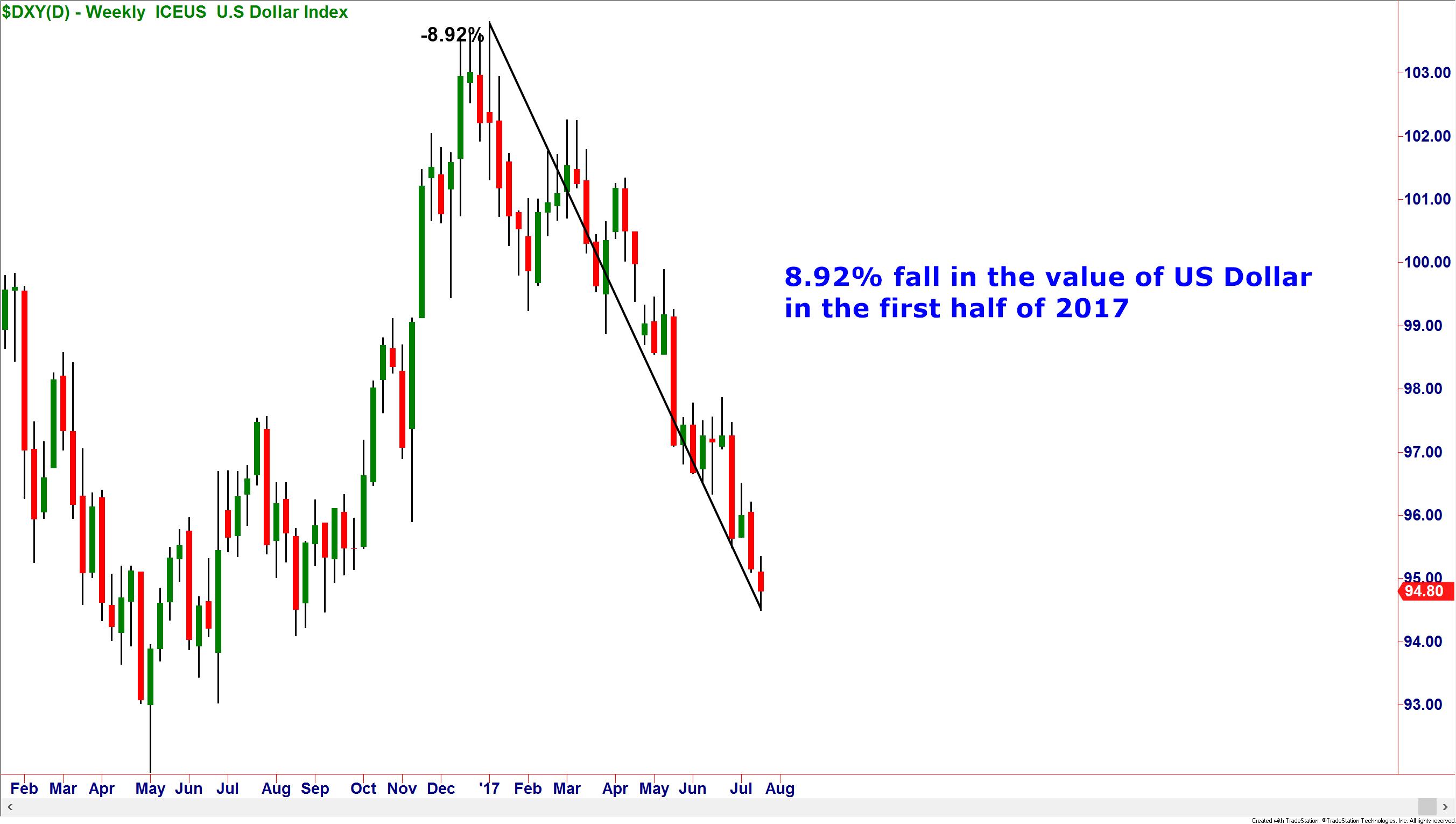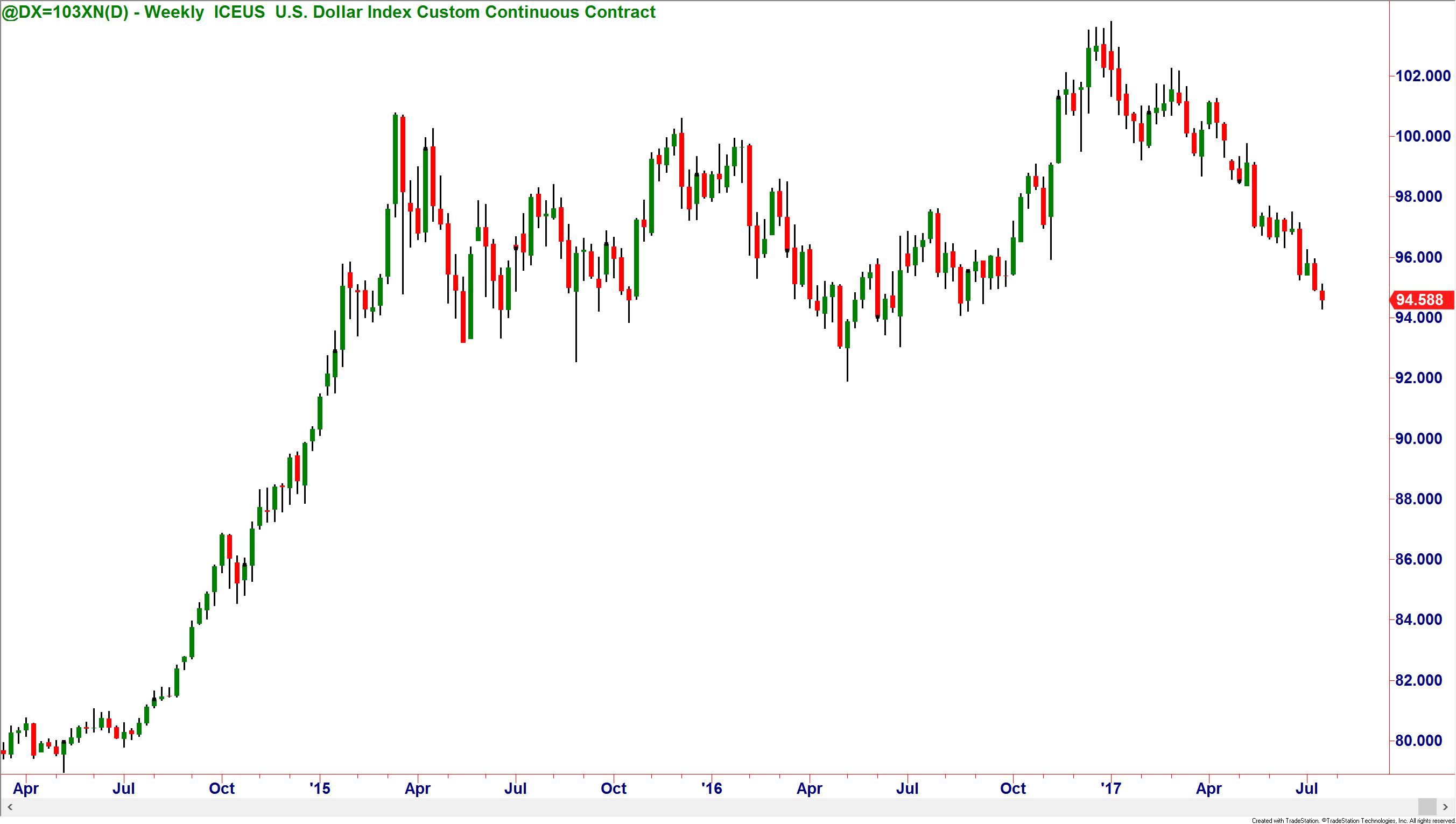Hello and welcome to another offering of Lessons from The Pros. I hope things have been going well for all of our readers in these recent months of market volatility. So far, this has been a pretty interesting Summer! Sometimes the global financial markets can be a little quiet around this time of the year, but so far there has been plenty of action for traders and investors to consider, with much of the activity being driven by the impact of the recent decline of the US Dollar.
The Dollar is always at the center of the markets, mostly the result of its ongoing status as the world’s primary reserve currency. Money flows in general, dictate that when price moves from one asset it only goes to another; and there have been large outwards flows from the Greenback over the last few weeks. The change in the value of the dollar has a huge impact on everyday life, and more and more people have been approaching me lately to ask about how to hedge the up and down moves they see happening.
Firstly, let me say that I think it’s a good idea to be thinking about hedging the value of the US dollar, especially considering things like inflation (which has been a rate of around 3% over the last 25 years, meaning your money loses half its value every 24 years!) and the general cost of living that affects most of us in everyday life. It’s amazing how many people I find worldwide that completely forget about the impact of the buying power of their home currency. More and more people are setting up international online business, doing transactions across the globe in various currencies. Just think about how a change in the value of your money will impact your profits. Why should you suffer just because your currency is? Anyone hoping to take a greater level of control in their financial future really does need to be aware of how they can hedge themselves in these market conditions.
The first thing you need to look at is a way of tracking the value of the dollar itself, and that will come from looking at a chart of the Dollar Index market. The dollar index is much like any stock market index and is derived from a basket of currencies valued against the dollar itself in a price weighted format. The currencies involved are the Euro, the British Pound, the Japanese Yen, the Swedish Krona, the Canadian Dollar and the Swiss Franc. Since there were far more currencies in the European Union before the establishment of the Euro single currency, the Euro itself carries the greatest price weighting in the dollar index, which is 57.6% of the entire index with 13.6% to the Yen, 11.9% to the Pound, 9.1% to the Canadian Dollar, 4.2% to the Krona and 3.6% to the Swiss Franc.
The Dollar Index chart looks like this:
As you can see from the picture above, the chart looks pretty much like any other market and that is exactly how it should be treated. This year alone we have seen a decline of almost 9% in the dollar. In spite of this, we can still apply the Online Trading Academy core strategy to find objective levels of supply and demand that the institutions are creating on the dollar index, just like we would on any other currency pair, stock or futures contract. However, the Dollar index itself cannot be traded as an index. Therefore, we would have to look to a derivative of the index.
Thankfully, one such product exists and that is the dollar index futures contract, which looks like this:
Above we have a screenshot of the dollar index futures contract. This looks much like a mirror image of the other chart, doesn’t it? Well, that’s because it’s a derivative of the dollar index and therefore will move in the same way and create the same levels of supply and demand for trading entries and exits. There will be minor changes in the prices here and there as this is a derivative product, however, across the board it is generally the same as the cash index chart itself. The contract is simply known as the Dollar Index Futures and its trading symbol is DX.
The contract itself trades on ICE exchange (Intercontinental Exchange) and is valued at any given time in the following manner: $1000 x the Index Value. So, when the DX was trading at 94.588, as in the above chart, this would make the value of 1 contract to be $94,588. The margin required to trade this product on ICE is set by the exchange itself and is currently, at the time of writing, $1980 initial and $1800 maintenance per contract, giving significant leverage to work with. A single tick fluctuation is worth $5.00 profit or loss.
As we can see, the DX futures contract is a great way for any market speculator to participate in the movements of the currency for both speculative and hedging purposes. It’s a decent size product with a good margin and not too much exposure. Yet for every positive there is often a negative, in this case that negative being that you would need to fund the futures account and pay for the data feeds required to trade the product. Some of you reading this may, therefore, be looking at this as probably not the most economical way to hedge the price of the US dollar. There is a solution at hand though and let me assure you that you probably already have access to engage it.
Let’s look at one more chart:
Does this chart look familiar to you? If you are an active FX trader, then you will notice immediately that it’s a chart of none other than the EURUSD. When compared to the chart of the DX contract, you will see that it is pretty much a direct inverse of the DX, with the bonus of a 12% gain this year against the USD loss of 9%. This is because the Dollar Index itself is made up of over half price-weighting by the Euro, hence both markets and charts have a very high degree of correlation.
So, to keep things simple as a spot FX trader, you can trade the EURUSD pair as a substitute to trading the DX contract itself. The only thing to remember is that one will be hitting levels of Demand when the other will be hitting levels of Supply. Keep this in mind and you have for yourself an easy way to hedge yourself on the Dollar. I hope you found this useful.
Note: All information on this page is subject to change. The use of this website constitutes acceptance of our user agreement. Please read our privacy policy and legal disclaimer. Opinions expressed at FXstreet.com are those of the individual authors and do not necessarily represent the opinion of FXstreet.com or its management. Risk Disclosure: Trading foreign exchange on margin carries a high level of risk, and may not be suitable for all investors. The high degree of leverage can work against you as well as for you. Before deciding to invest in foreign exchange you should carefully consider your investment objectives, level of experience, and risk appetite. The possibility exists that you could sustain a loss of some or all of your initial investment and therefore you should not invest money that you cannot afford to lose. You should be aware of all the risks associated with foreign exchange trading, and seek advice from an independent financial advisor if you have any doubts.
Editors’ Picks
AUD/USD posts gain, yet dive below 0.6500 amid Aussie CPI, ahead of US GDP

The Aussie Dollar finished Wednesday’s session with decent gains of 0.15% against the US Dollar, yet it retreated from weekly highs of 0.6529, which it hit after a hotter-than-expected inflation report. As the Asian session begins, the AUD/USD trades around 0.6495.
USD/JPY finds its highest bids since 1990, approaches 156.00

USD/JPY broke into its highest chart territory since June of 1990 on Wednesday, peaking near 155.40 for the first time in 34 years as the Japanese Yen continues to tumble across the broad FX market.
Gold stays firm amid higher US yields as traders await US GDP data

Gold recovers from recent losses, buoyed by market interest despite a stronger US Dollar and higher US Treasury yields. De-escalation of Middle East tensions contributed to increased market stability, denting the appetite for Gold buying.
Ethereum suffers slight pullback, Hong Kong spot ETH ETFs to begin trading on April 30

Ethereum suffered a brief decline on Wednesday afternoon despite increased accumulation from whales. This follows Ethereum restaking protocol Renzo restaked ETH crashing from its 1:1 peg with ETH and increased activities surrounding spot Ethereum ETFs.
Dow Jones Industrial Average hesitates on Wednesday as markets wait for key US data

The DJIA stumbled on Wednesday, falling from recent highs near 38,550.00 as investors ease off of Tuesday’s risk appetite. The index recovered as US data continues to vex financial markets that remain overwhelmingly focused on rate cuts from the US Fed.
RECOMMENDED LESSONS
Making money in forex is easy if you know how the bankers trade!
Discover how to make money in forex is easy if you know how the bankers trade!
5 Forex News Events You Need To Know
In the fast moving world of currency markets, it is extremely important for new traders to know the list of important forex news...
Top 10 Chart Patterns Every Trader Should Know
Chart patterns are one of the most effective trading tools for a trader. They are pure price-action, and form on the basis of underlying buying and...
7 Ways to Avoid Forex Scams
The forex industry is recently seeing more and more scams. Here are 7 ways to avoid losing your money in such scams: Forex scams are becoming frequent. Michael Greenberg reports on luxurious expenses, including a submarine bought from the money taken from forex traders. Here’s another report of a forex fraud. So, how can we avoid falling in such forex scams?
What Are the 10 Fatal Mistakes Traders Make
Trading is exciting. Trading is hard. Trading is extremely hard. Some say that it takes more than 10,000 hours to master. Others believe that trading is the way to quick riches. They might be both wrong. What is important to know that no matter how experienced you are, mistakes will be part of the trading process.




